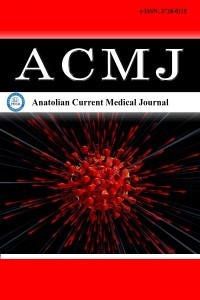1.
Whyte A, Boeddinghaus R. The maxillary sinus: physiology, development and imaging anatomy. Dentomaxillofac Radiol. 2019;48(8):20190205.
2.
Şakul BU, Bilecenoğlu B. Baş ve boynun klinik bölgesel anatomisi. Özkan Matbaacılık: 2009.
3.
Ogle OE, Weinstock RJ, Friedman E. Surgical anatomy of the nasal cavity and paranasal sinuses. Oral Maxillofac Surg Clin North Am. 2012;24(2):155-166.
4.
Gulec M, Tassoker M, Magat G, Lale B, Ozcan S, Orhan K. Three-dimensional volumetric analysis of the maxillary sinus: a cone-beam computed tomography study. Folia Morphol. 2020;79(3):557-562.
5.
Magat G, Tassoker M, Lale B, Güleç M, Ozcan S, Orhan K. Comparison of maxillary sinus volumes in individuals with different dentofacial skeletal patterns: a cone-beam computed tomography study. EÜ Diş Hek Fak Derg. 2023;44(1):17-23.
6.
Temur KT. Maksiller sinüs patolojilerinin ve osteomeatal kompleksin radyolojik olarak değerlendirilmesi. Arş Kaynak Tarama Derg. 2018;27(3):328-345.
7.
Jasim HH, Al-Taei JA. Computed tomographic measurement of maxillary sinus volume and dimension in correlation to the age and gender: comparative study among individuals with dentate and edentulous maxilla. J Baghdad Coll Dent. 2013;325(2204):1-7.
8.
MacDonald-Jankowski DS, Li TK. Computed tomography for oral and maxillofacial surgeons. Part I: spiral computed tomography. Asian J Oral Maxillofac Surg. 2006;18(1):7-16.
9.
Dedeoğlu N, Altun O, Bilge OM, Sümbüllü MA. Evaluation of anatomical variations of nasal cavity and paranasal sinuses with cone beam computed tomography. Evaluation. 2017;13(2):36-41.
10.
Weber AL. History of head and neck radiology: past, present, and future. Radiology. 2001;218(1):15-24.
11.
Seth V, Kamath P, Venkatesh M, Prasad R. Cone beam computed tomography: third eye in diagnosis and treatment planning. Virtual J Orthod. 2011;9(1):1.
12.
Palomo JM, Kau CH, Palomo LB, Hans MG. Three-dimensional cone beam computerized tomography in dentistry. Dent Today. 2006;25(11):130.
13.
Özer SGY. Konik ışınlı bilgisayarlı tomografi’nin endodontide uygulama alanları. GÜ Diş Hek Fak Derg. 2010;27(3):207-217.
14.
Aktuna Belgin C, Colak M, Adiguzel O, Akkus Z, Orhan K. Three-dimensional evaluation of maxillary sinus volume in different age and sex groups using CBCT. Eur Arch Otorhinolaryngol. 2019;276(5):1493-1499.
15.
Sahlstrand-Johnson P, Jannert M, Strömbeck A, Abul-Kasim K. Computed tomography measurements of different dimensions of maxillary and frontal sinuses. BMC Med Imaging. 2011;11(1):8.
16.
Bornstein MM, Ho JKC, Yeung AWK, Tanaka R, Li JQ, Jacobs R. A retrospective evaluation of factors influencing the volume of healthy maxillary sinuses based on CBCT imaging. Int J Periodontics Restorative Dent. 2019;39(2):187-193.
17.
Shrestha B, Shrestha R, Lin T, et al. Evaluation of maxillary sinus volume in different craniofacial patterns: a CBCT study. Oral Radiol. 2021;37(4):647-652.
18.
Sarilita E, Lita YA, Nugraha HG, Murniati N, Yusuf HY. Volumetric growth analysis of maxillary sinus using computed tomography scan segmentation: a pilot study of Indonesian population. Anat Cell Biol. 2021;54(4):431-435.
19.
Butaric LN. Differential scaling patterns in maxillary sinus volume and nasal cavity breadth among modern humans. Anatomic Rec. 2015;298(10):1710-1721.
20.
Holton NE, Yokley TR, Franciscus RG. Climatic adaptation and neandertal facial evolution: a comment on Rae et al. (2011). J Hum Evol. 2011;61(5):624-627.
21.
Selcuk OT, Erol B, Renda L, et al. Do altitude and climate affect paranasal sinus volume? J Craniomaxillofac Surg. 2015;43(7): 1059-1064.
22.
Taştemur Y, Öztürk A, Sabancıoğulları A, et al. The relationship between anatomical variations and paranasal sinus volumes with climate and altitude.Cumhuriyet Med J. 2022;44(4):420-429.
23.
Ariji Y, Kuroki T, Moriguchi S, Ariji E, Kanda S. Age changes in the volume of the human maxillary sinus: a study using computed tomography. Dentomaxillofac Radiol. 1994;23(3):163-168.
24.
Urooge A, Patil BA. Sexual dimorphism of maxillary sinus: a morphometric analysis using cone beam computed tomography. J Clin Diagn Res. 2017;11(3):ZC67.
25.
Ekizoglu O, Inci E, Hocaoglu E, Sayin I, Kayhan FT, Can IO. The use of maxillary sinus dimensions in gender determination: a thin-slice multidetector computed tomography assisted morphometric study. J Craniofac Surg. 2014;25(3):957-960.
26.
Degermenci M, Ertekin T, Ülger H, Acer N, Coskun A. The age-related development of maxillary sinus in children. J Craniofac Surg. 2016;27(1):e38-e44.
27.
Karakas S, Kavakli A. Morphometric examination of the paranasal sinuses and mastoid air cells using computed tomography. Ann Saudi Med. 2005;25(1):41-45.
28.
Saccucci M, Cipriani F, Carderi S, et al. Gender assessment through three-dimensional analysis of maxillary sinuses by means of cone beam computed tomography. Eur Rev Med Pharmacol Sci. 2015;19(2):185-193.
29.
Cohen O, Warman M, Fried M, et al. Volumetric analysis of the maxillary, sphenoid and frontal sinuses: a comparative computerized tomography-based study. Auris Nasus Larynx. 2018;45(1):96-102.

